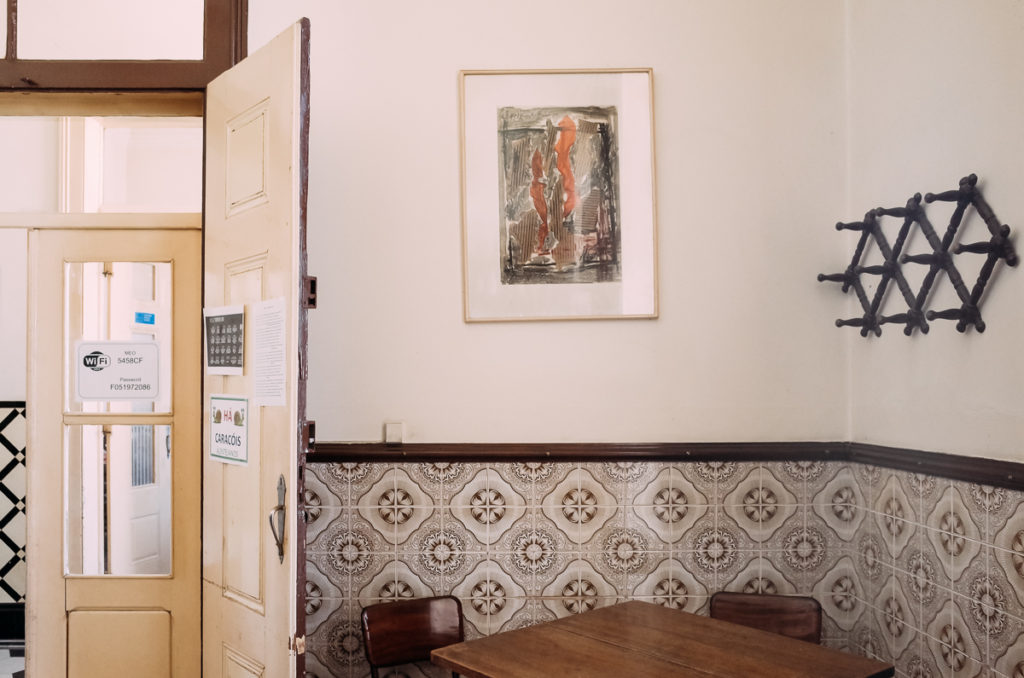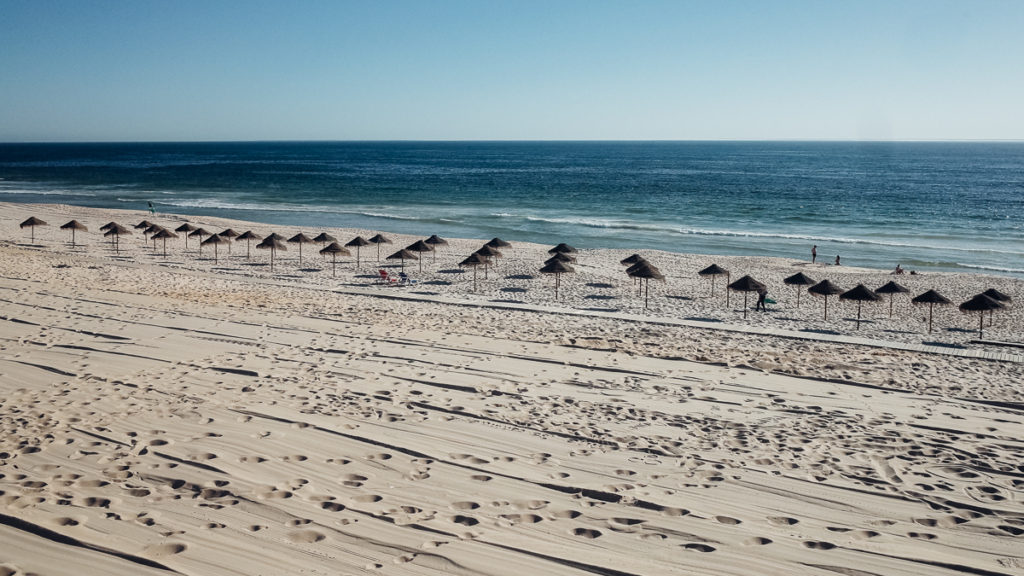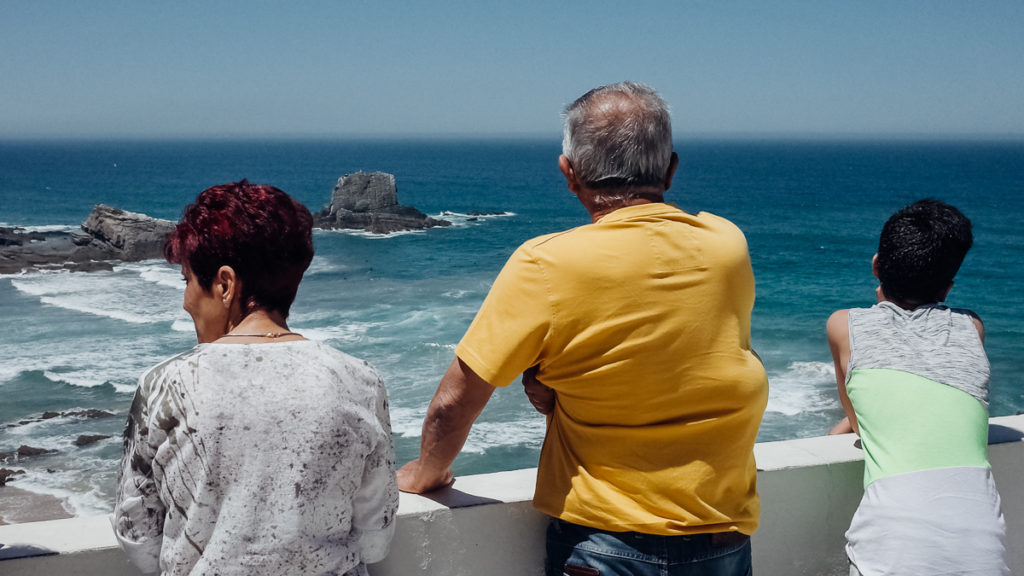Dear Barbara,
It’s early in the morning, and the heat is intense. I thought of leaving Elvas as early as possible to avoid riding a boiling car. As I wrote to you in the previous letter, I am going again to the coast of Alentejo. But this time I’m about to explore the northern part of the coast, the area between the socialist-spirited Grândola and the sleepy Comporta. The locals told me last night that this is one of the nicest areas in the region. A long road trip to Alentejo should finish with a visit to this side of the Costa Alentejana.
Already at 10 am the temperature is well beyond 30 C. The car is insanely hot, and I must turn on the air conditioner. I leave Elvas behind looking for one last time the impressive Aqueduct. It looks totally like a sci-fi movie set, definitely different from the one in Chiatura, but for sure equally staggering.
And then I’m on the highway. It’s two and a half hours to the coast of Alentejo, and I think I’ll have a coffee-break halfway.
A charming Alentejo scene in Montemor-o-Novo

A bit more than a hundred kilometers later, I exit the highway. Shortly after crossing the outskirts of Évora, there is a sign pointing to either Montemor-o-Novo or Arraiolos. I’ve read that both places are beautiful, but I find it hard to decide which one to visit. I just follow my gut feeling, and ten minutes later, I find myself in Montemor-o-Novo.
As you probably remember from my previous letters from Alentejo, the most significant settlements of the region come with castles. Montemor-o-Novo has one too, although I find it slightly less spectacular than the ones I’ve already visited. The town itself is beautiful though, a typical whitewashed Alentejo settlement that features lovely squares and some facades covered in azulejos. It’s unfortunately hot beyond words in Montemor-o-Novo, as pretty much everywhere in the mainland of Portugal.
I’m searching desperately for a place to have an espresso. When I arrive at the Republic Square, I see a cafe named Almansor that seems very local. But on the other side of the square, I see a much bigger building with outdoor sitting. There are a few umbrellas and some chairs that look comfortable, so I’m walking towards its entrance. I enter the building expecting to find a proper cafe, but the place looks more like a bar. Three people are sitting on a table (two men and one woman), and they talk passionately about something that I fail to understand. Then the older of the three guys ask me if I want a coffee.
I need a coffee indeed, and I order a small cake that looks fresh. Smoking is allowed, and I take advantage of the regulation. I light a cigarette, and I sit inside since the yard is too hot. As for the place, it turns out that it belongs to the Carlista Association of Montemor-o-Novo. It’s called Pedrista, and it was founded in 1891. Pedrista had one goal back then: to start a new Philarmonic band. The plan apparently succeeded.
Meanwhile, the three guys go deeper and deeper into their conversation. It might be something about music. I don’t want to interrupt them, and I stay there, looking at old bottles, staring at fresh cakes, imagining musicians arguing from dusk till dawn about -what else- music.
Twenty minutes later, though, I do interrupt them. It’s time for me to go: I must see, once again, the Atlantic Ocean.
Reaching the coast of Alentejo again

After crossing several settlements dedicated to saints (São Romão, São Cristóvão, Santa Susana, Santa Catarina), I get a glimpse of Alcácer do Sal. This is a town with an illusion of coastline: the river Sado runs through it. But without any reason at all, I feel that I’m in a rush and I don’t stop at all at Alcácer do Sal. I see it behind my car window, and it looks like a decent place to stop for a couple of hours.
I can’t wait to be in front of the sea. It takes approximately another 40 minutes to my accommodation, and when I first smell the pine trees, I feel like celebrating. One by one, all the summer smells request my attention -and I can only surrender to them. And then, a narrow road drives me at Monte do Brejinho de Água.
This is a renovated farm that offers accommodation in Brejinho de Água, located a few kilometers away from the ocean. Nuno is a very nice guy, offering advice and information about the best things to do in this part of the Costa Alentejana. My room is spacious and clean and comes with a large terrace overlooking the fields. I was lucky with my accommodations on my Alentejo road trip: I enjoyed everywhere open space, fresh air, and walking barefoot on terraces and verandas.
Twenty minutes later, and straight after carrying my luggage to the room, I enter the car again. It’s just 10 minutes to the closest beach, but I’m going slightly farther away.
Fiasco at Praia da Galé – Fontainhas

Nothing bad happened to me at Praia da Galé – Fontainhas. That’s the beach I thought of visiting, but all I can tell you is a couple of stories about the wonderful view. The beach? I never visited it.
You see, the road ends in front of a Camping and from there it’s supposedly easy to reach the beach. There’s no sign there though, and I decide to trust Google Maps. The truth is that Google Maps is trustworthy in urban places, but it often suffers when I find myself off the beaten path. According to Google Maps, I should go towards the left, and from there a small path will drive me to the beach.
And, indeed, I go to the left. There is a path but not a proper one. It consists of soft sand under some trees -and the sea is nowhere to be seen, just to be heard. I know I’m probably on the wrong path, but I decide -like an idiot- to take it. At some point, I have the feeling that I’m walking on moving sand -but I carry on. Twenty minutes later, after walking on an awful surface and with a temperature of 36 degrees burning my head, I end up in the middle of nowhere.
Sure, the view is breathtaking: an impressive sandy beach and the Atlantic Ocean in Alentejo. But there is no path to walk down to the beach. I see the big waves of the ocean and some courageous surfers taming them. I admire their discipline and their fearlessness, but most of all, I admire the landscape.
All my admiration is gone, though on the way back because my shoes get damaged. It’s my only pair, I have failed to reach the sea, I’m swearing, and I’m sweating. What I find out later is that the entrance to the beach in on the right side, not on the left, and of course one can reach it by walking through the Camping.
After the island I didn’t visit due to laziness, here is the beach I didn’t visit because of stubbornness.
The winds of Praia do Pego

The Praia do Pego is a wide sandy beach featuring a restaurant on one edge and some umbrellas. I’m not a fan of organized beaches, but I’m here before the high season, and the place is not packed. I actually doubt if it ever is.
The wind is strong in Praia do Pego, and it’s hard to spend time on the beach. According to the forecast, the sea temperature is about 15 degrees. By Greek standards, this translates as “forget swimming,” and I guess by Portuguese standards too -there’s no one around. And yet, as if the northern part of Alentejo’s coastline makes me stubborn, I decide to get into the water.
It’s not so cold as it was at Zambujeira do Mar, but it’s far from being pleasant too. The waves are relatively high, but here the sea is shallow. It actually feels less cold in the water than on the beach. Seagulls fly above my head, and it’s an amazing experience to be the only person swimming in the Atlantic shortly before sunset, in an empty beach.
The difference with the Southern Coast of Alentejo

I spend a couple of days on the northern coast of Alentejo. Although I love being at the beach, I move from town to town, I visit villages, and I talk with the locals. The food is wonderful here, too, and I’m trying to eat fish every day. Kindness, the Atlantic Ocean, fine food. And yet, something is missing.
I have no regrets at all for being here. On the contrary, I wish I could stay longer. But quite often, I find myself missing the days on the southern coast of Alentejo, missing the area around Zambujeira do Mar. There should be a reason for that.
And indeed, one of the last days everything becomes clear. I’m eating at the restaurant Mira Ponte a delicious seabass. The waiter is polite beyond words, but there is some distance in his manners. That’s probably what bothers me on this side of Alentejo. The southern part of the region was totally unpretentious in its manners, rougher in terms of sea, and more interesting in its food. On the other hand, all these qualities have been flattened out on the northern part.
It might be the proximity to Lisbon that comes like a cold wave on the northern coast of Alentejo, altering slowly behaviors, tastes, and, eventually, the sea itself. Don’t get me wrong: I love Lisbon, I find it one of the most sophisticated capitals of Europe. But the truth is that every capital is always smoother in manners than the province. Grândola, Comporta, and all the places around them offer some real Alentejo feeling, but I think that the most original one is to be found on the southern part of the coastline.
It might have to do with the slow invasion of tourism in the area, too. But Alentejo is an original region, full of wine, great people, and tall waves -and I truly hope that it will keep its character intact.
A thousand waves and me
I thought I’d stay here forever, in front of the charming waves of Alentejo. But this is my last afternoon in Alentejo, and I choose to have an easy-going one. I don’t pack any provisions for the day, no food, no water. All I have with me is my camera and a towel. I’m just going to spend the day at the beach.
I arrive in the early afternoon at Carvalhal beach. It’s a Friday, and it’s the first time I see quite some people under the umbrellas. This is an organized beach, but it’s so wide that I can isolate myself easily. I’m actually searching for a spot that I can be all alone, and after finding it, I lay my towel on the hot sand. From there, I can observe the whole beach of Carvalhal, but at the same time, I can listen to the waves. The insects seem desperate in this area. At any given moment, I can see more than twenty walking on my skin.
The sea in Carvalhal is not deep. On the other hand, every now and then the Atlantic pushes some huge waves towards the coast. I see numerous heads observing the waves, but just two or three of them decide to swim. The spectacle is really tempting: the ocean is moving like a giant searching for a place to conquer. I can’t stay any more ashore; soon, I’m again into the water.
What an unbeatable feeling. The water is cold, and the current is strong. I let the Atlantic move me wherever it wishes. I ride the waves. There are thousands of them. Sometimes they are mild, but there are other times that I’m afraid I’ll end up in the Azores. I once wrote to you about the departing sea of Anafi; however, on the coastline of Alentejo, I observe the opposite thing. The sea is always arriving.
And then, after an hour into the water, I have an idea. How many times will I return here? Hopefully many, but maybe never again. Therefore, I thought of having a photo of myself swimming -or at least, trying to- in the Atlantic Ocean. I set the tripod on the beach, I set the timer, and I go quickly in again. Hot sand, cold water, huge waves, that’s the triptych of Alentejo’s coast. I can’t hear the clicks of the camera; I can only listen to the waves.
Goodbye, Alentejo

It’s still hot beyond words in Alentejo. I have a quick breakfast at Monte do Brejinho de Água, and then I pack my luggage.
It’s now one o’clock in the afternoon, and I’m on the way to Lisbon. I have a late afternoon flight back to Berlin. It has been a wonderful time here in Alentejo, in Portugal’s most charming area. There’s no overnight stay in Lisbon this time; I only have time for a quick espresso and a last pastel de nata.
One always thinks that happy days will never end. But they do come to an end, and as I see the skyline of Lisbon in front of me, I promise to myself to return in Alentejo, with you.
See you soon,
George
More travelogues about Alentejo: The first part (Alentejo Litoral) & The second part (Central Alentejo)
My comprehensive travel guide to Alentejo: Read it here
Best prices for renting a car in Alentejo
*Get my FREE Travel Writing Course*
Buy the camera I use | Book your hotel in Alentejo
Pin it for later

Please share, tweet, and pin if you enjoyed reading Back to the coast of Alentejo. Your support keeps this website running and all the info up-to-date. 🙂
Last Updated on May 23, 2020 by George Pavlopoulos

Nice article. Seems like a nice place to visit. I’ll visit the place soon
Thanks a lot. Yes, you should visit Alentejo, it’s a wonderful region.